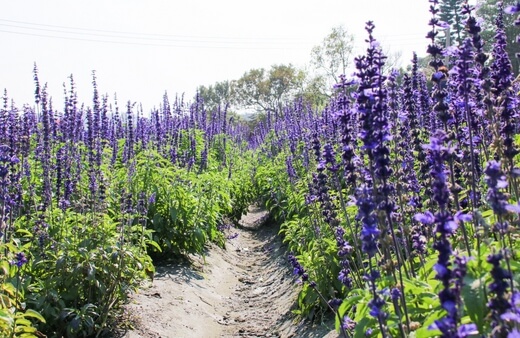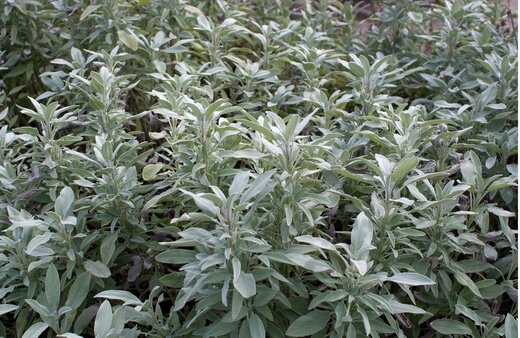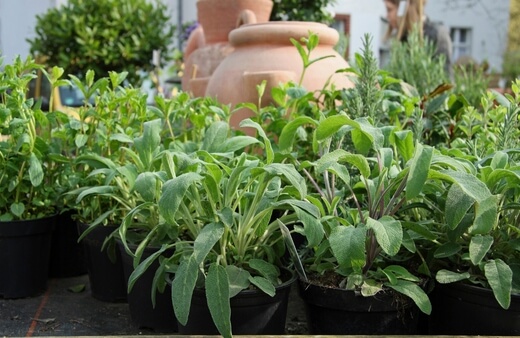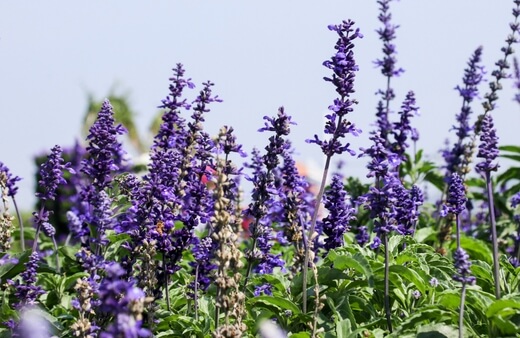Apple sauce, baked and infused with fresh common sage leaves is one of the most comforting autumnal treats imaginable, but there’s a whole year of potentially harvestable sage out there before you get to that point, and we’ve got a rundown of everything you need to know about growing this richly flavoured herb, and all of its ornamental cousins.
This guide shares insights into growing your own at home, indoors and out, and can be adapted to suit various ornamental sages, as well as the common sage, Salvia officinalis.
More...

Family: | Lamiaceae |
|---|---|
Genus: | Salvia |
Species: | S. officinalis |
Common Names: | Sage, Common Sage |
Location: | Outdoor (can be grown indoors) |
Type: | Herb, Herbaceous perennial |
Growth: | 20cm-1m tall, 20cm-1m spread |
Sun requirements: | Full sun |
Foliage Colour: | Silvery green |
Flower Colour: | Purple |
Flowering: | Late summer |
Fruit: | None (edible leaves on most cultivars) |
Maintenance level: | Low |
Poisonous for pets: | Non-toxic to cats and dogs |
What is Salvia officinalis?

Common sage, or Salvia officinalis, is one of the most commonly cultivated herbs in the world. Its culinary uses are limitless, adding savoury notes to sweet dishes, as well as rounding the flavour of savoury sauces.
Salvias are widely cultivated beyond Salvia officinalis, but the common sage we know and love is a selected group of cultivars in the Salvia genus. Thankfully, once you know how to grow one salvia, the rest fall into place pretty neatly.
Common Sage’s Natural Habitat
Salvia officinalis is native to the Mediterranean, but grows wild in mild, temperate and tropical climates all over the world thanks to its easy-going growth habits.
While some sages are more frost tender than others, most will survive even deeply frozen winters, provided their roots remain free from damp conditions.
Other Types of Salvias to Grow at Home
Salvia officinalis or the common sage is the most commonly grown salvia in the world, but it is by no means the most exciting. Most other salvias are grown for their ornamental value, but some are also edible, adding anise flavours and a touch of sugary sweetness to meals, both in their flowers and leaf.
Check out our guide to the best salvias to grow in Australia for a run-through of our favourite types, and how best to adapt your garden to their needs.
Growing Salvia officinalis in Australia
Sage needs water, but it really is picky about how much. The best way to manage your watering for sage is to get its soil right from day one. Any free-draining, gritty or sandy soil will provide an ideal habitat for sage, which will produce masses of tasty leaves for the kitchen provided it doesn’t become completely waterlogged.
The only benefit of improving moisture retention is improved flowering, and the potential edible flowers you can harvest as a result. Other than that, it’s much safer to keep sage in free-draining conditions all year round.
Planting Sage Outdoors

Growing common sage outdoors in Australia is incredibly simple, largely because we share many climate traits with the Mediterranean, and our soil and drainage conditions are virtually identical across the country, though our summers, particularly on the east coast can be a little warmer, and more humid than these drought tolerant plants like.
Soil & Drainage
Start by providing your common sage with the right soil. Like most herbs, nutrient access is important, so a slightly acidic soil (around 6 pH) is ideal, which supports the uptake of essential nutrients and macronutrients like calcium and iron.
For sage grown in the ground, add a couple of handfuls of organic matter to sandy soil so there is some moisture retention. For sage planted in clay soils, add sand and grit to reduce moisture retention.
The ideal drainage can be tested by digging a 15 cm hole (deep and wide) and filling it with water. Once the first puddle drains, re-fill the hole. If the area drains in under half an hour, your sage should be quite happy there.
Spacing
Sage comes in a few different cultivars, usually by cross-breeding with other salvias, so spacing will depend on the overall size of each plant. For young salvia in a loose soiled herb garden, plant them about 30cm apart, which will be enough for their first two to three years.
When they get bigger, they can be spaced apart, or pruned to provide aeration between stems.
Light
Sage needs full sun. There is no salvia I have ever grown that can cope with anything less than 6 hours of direct light per day.
Water
Sage herb should be kept moist, but never damp. If the top 2” of soil are at all wet, do not water them and wait until the soil dries out before watering again. Like most Mediterranean plants, the biggest danger to their health is root rot from overwatering.
Pruning Common Sage
In cold parts of the country, sage should be cut back hard in winter as frost will kill off the top growth. Provide protection from frosts to the lower stems by using horticultural fleece.
Generally pruning sage and salvias by 1/3 to 1/2 each year is good practice too, as it supports the maintenance of a well-rounded doming shape, particularly for shrubby salvias, which can become hollow in their centres, which fill with old brittle wood.
If your sage or salvia has become hollow in the centre, cut it back hard in spring when new growth starts. This triggers old nodes to re-sprout, producing fresh green shoots in the centre of the plant.

Growing Common Sage Indoors
The best place to grow sage is outdoors. Once mature, sage can reach a spread of 1m and a similar height on a single main stem, so indoor growing can be very challenging.
However, for outdoor kitchens, or well-ventilated indoor kitchens, there are few more striking potted herbs than a mature sage near the window, acting as a natural air freshener every time a breeze rushes past.
- To grow sage herb successfully indoors, you’ll need to fill a large enough pot with a very gritty compost, making sure to provide thorough drainage at the base (we use old broken pots as crocks to keep some air around the drainage holes).
- Choose a pot that is no more than 2” wider than the existing root ball, as excess soil can become saturated. As the sage grows, move it to bigger pots each year.
- Once potted up, place the container over a drainage plate, and raise the pot about 1 cm off the plate with ceramic feet or tiles.
- Water generously once a week in summer, or when the top 2” of soil is dry to the touch.
Propagating Common Sage Herb
There are three super simple ways to propagate sage, each offering speed at different growth stages. Growing common sage from seed will quickly produce new plants, but won’t provide enough leaves for use in the kitchen for the first year.
Growing sage from cuttings is an efficient way to create medium-sized plants quickly, especially for growing sage indoors. Growing sage by layering, a method we’ll look at later, will allow you to continue harvesting from your existing plant, with the bonus of new plants that root in situ, without any specialist tools.

How to Propagate Sage from Seed
Common sage grown from seed is slow to establish, but it’s the best way to create loads of new plants in a small space, especially if you don’t already have a sage plant to start with.
Simply fill a seed tray with loose, well-drained compost, and thinly sow sage seeds onto the surface. Wet the soil, and leave it somewhere warm and bright, but out of direct light.
After germination, wait until they have true leaves and are large enough to handle, before pricking them out into individual pots. When the roots fill each pot, they can be planted into containers for their first year, or until they are large enough to plant into the ground.
Common Sage Propagation from Cuttings
Common sage grown from cuttings is quick to establish, and a great way to keep a rolling supply of young sage growing in the kitchen.
- Start by taking a cutting in spring that includes young leaves, 10-15cm of stem, and no flower buds.
- Dip the cutting in rooting hormone and strip the lower leaves.
- Carefully insert your cutting into a pot filled with seed and cutting compost.
- Water well and leave out of direct sunlight for about two months, misting if the soil dried out.
- Repeat this process with several cuttings as they can rot off, so it's worth taking four or five at a time to boost your chances.
Check out our guide on the different types of rooting hormones and how to use them.
Propagating Common Sage from Layering
Layering is a simple process, and doesn’t require any compost, pots, or even water. All you need to do is peg the lowest branch of your sage into the soil.
- Keep the branch attached to the original plant, and bend it gently towards the ground in early spring.
- Scrape away a very small section of bark around a leaf node, and remove the leaf, then peg it to the ground.
- Cover with soil from the surrounding area.
- By early summer, there should be a new plant emerging from the buried section of stem, and if there are roots, you can cut it away from the parent plant.
- Carefully dig up the new plant, roots and all, place it in a pot, slightly larger than its root ball, and cover it with gritty compost.
Common Sage Possible Problems
Sage is famously good at deterring spiders and other insects around the house and actively works out in the garden to repel insects. However, that doesn’t make it bullet proof, and some common Mediterranean pests can still attack sage here in Australia.
Pests
Aphids, Rosemary leaf beetles and Liguerian leafhoppers are all common pests on sage, particularly in late spring when the new growth and shoots are flourishing, and providing plentiful chlorophyll for these sap-sucking bugs to feast on.
Sage that is kept well watered, with lush foliage is often the first to suffer in spring, and keeping your plants slightly drier can often increase their resilience to pests (or reduce their appeal).
Diseases
When it comes to diseases, it’s a different story altogether. Sage really is very susceptible to all kinds of damp-related diseases and fungal infections. From downy mildew and powdery mildew to full-blown root rot. Knowing the signs will help to prevent recurrences, and hopefully treat the problem in time before it goes too far.
If you notice blackening stems on your sage, particularly near the base, is often a sign of a form of root rot, which begins as a result of waterlogging, or over-acidified soil. Remove any black stems immediately to prevent spread.
If your sage leaves are showing a white blooming coating, it is usually a form of mildew, a common fungal infection that catches on wet leaves. To avoid it, water sage at the base, and try not to splash the leaves. To treat it, remove the affected leaves and burn them, then treat the rest of the plant by adding a topical copper fungicide.
Salvia officinalis Frequently Asked Questions

What is sage used for?
Sage is used primarily as a kitchen herb, but also has various reported health benefits, from relaxation to reducing cholesterol. The most common use of sage is paired with mildly flavoured foods to boost umami and round off sweetness.
Can you eat sage leaves raw?
Sage leaves can be eaten raw, but they have a slightly fluffy texture that is pretty unpleasant in salads. Cooking sage, or boiling raw sage into teas and tinctures is the best way to get their flavour into your diet.
What parts of sage can you eat?
You can eat the leaves and flowers of sage plants, and while the stems are safe to eat, they have little flavour, and are not a good addition to cooking. Sage flowers have a milder flavour than sage leaves but have a sweeter aftertaste and can be eaten raw.
What can I do with a lot of fresh sage?
If you’ve got lots of fresh sage left over at the end of the growing season, and this time to prune the plant back, there are plenty of creative ways to store sage leaves. Sage butter (finely sliced and mixed through butter) can be cooked, or frozen for storage, and sage is easy to dry in the oven, or by hanging for a week.
Does sage help you sleep?
The gentle fragrance of sage is a natural air freshener, but it also has properties that help us to relax. While the fragrance isn’t for everyone, it does reportedly work as a very beneficial sleep aid.
Can you freeze sage leaves?
If you prefer to cut out the hard work of creating sage butters and drying your sage leaves, you can simply freeze the leaves in batches, provided you keep them in an airtight bag.
How do you know when sage is ready to pick?
You can pick sage leaves at any stage, and they will still have flavour even when the leaves begin to crisp and brown on the plant at the end of autumn or in early winter.
Perhaps the best time to harvest sage leaves though is when they are young and tender, as they cook down perfectly into soup with a barely detectable texture.
Wrapping Up Our Growing and Caring Guide for Salvia officinalis
Sage is an undersung hero of the kitchen, and with so many brothers, sisters, and cousins in the salvia family to choose from, there’s truly no excuse for not growing it in some form or other in your garden.
Whether it's for flavour, or as a reliable and structural shrub to grow as a mild and organic pest preventative, growing your own Salvia officinalis is a rewarding experience and a must for any gardener.
Published on March 8, 2023 by Maisie Blevins
Last Updated on February 23, 2024




